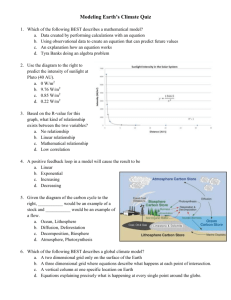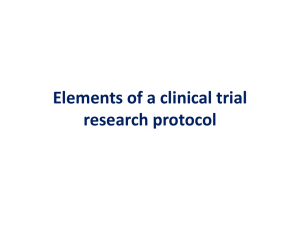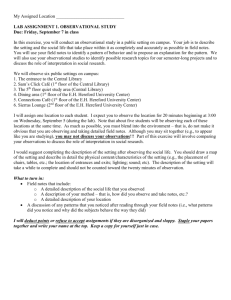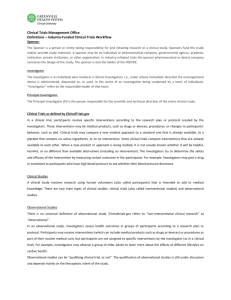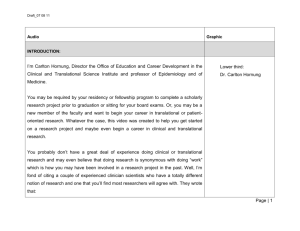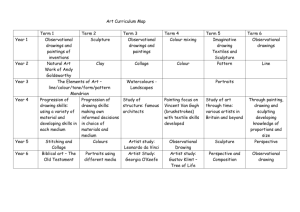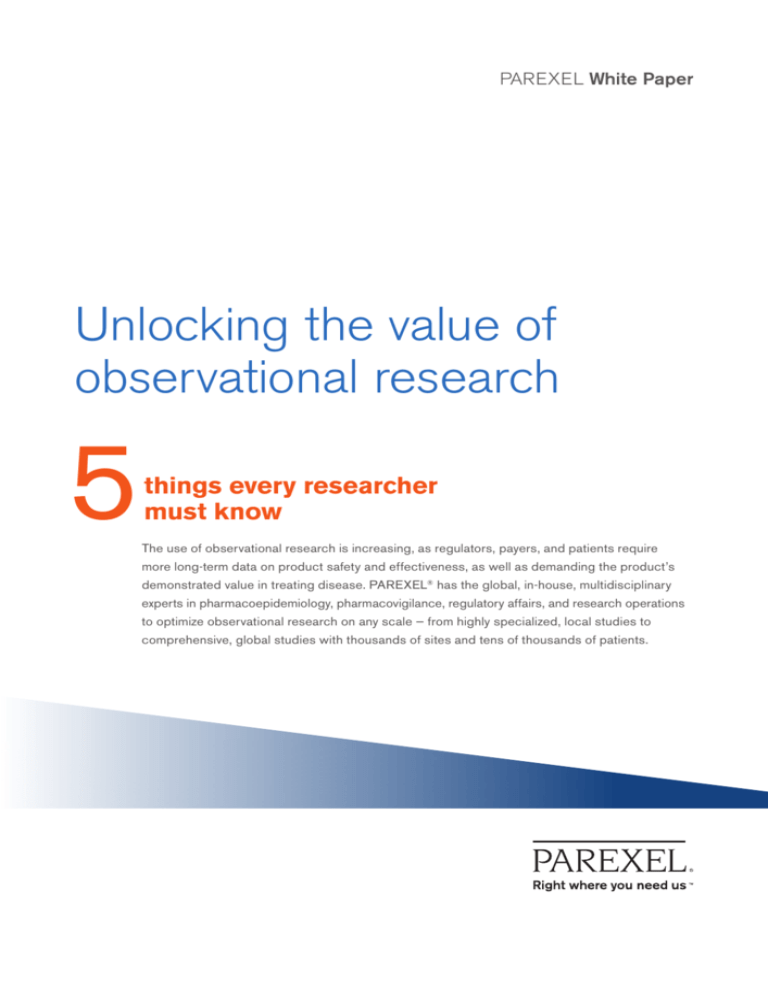
PAREXEL White Paper
Unlocking the value of
observational research
5
things every researcher
must know
The use of observational research is increasing, as regulators, payers, and patients require
more long-term data on product safety and effectiveness, as well as demanding the product’s
demonstrated value in treating disease. PAREXEL® has the global, in-house, multidisciplinary
experts in pharmacoepidemiology, pharmacovigilance, regulatory affairs, and research operations
to optimize observational research on any scale — from highly specialized, local studies to
comprehensive, global studies with thousands of sites and tens of thousands of patients.
Introduction
The use and scope of observational research studies within the pharmaceutical industry has increased
over past decades to include clinical, patient-reported, economic, and other health outcomes endpoints,
thereby giving value to multiple stakeholders for as many different purposes. Unlike randomized clinical trials,
observational studies allow for the evaluation of the use and effects of healthcare products (including drugs,
biologics, devices, vaccines) under conditions of usual care in a real world setting. This reference white
paper will empower the reader to understand and apply the fundamental principles of observational
research, and to take advantage of the value and potential of this approach.
This white paper gives an overview of the role
of observational research in the pharmaceutical
industry by exploring 5 basics:
1. The rationale for the conduct
of observational research
2. A high level overview of the
application of observational
research in clinical development
and life cycle management
3. Definitions of key observational
research terms
4.Descriptions of the main types
of observational research studies
5. A discussion of the governance of
observational research studies and
a review of the regulatory landscape
in the EU and US with respect to
regulation, legislation, and guidance
documents that influence the role
of observational research.
1
When should I conduct an
observational research study?
The driving forces to use observational
research studies in the pharmaceutical
industry are threefold:
Limitations associated with clinical
trials are commonly referred to as
“The Three Toos.”
1. W
hen treatment information under
conditions of usual care in a real-world
setting is needed.
Trials are considered ‘too narrow’ in that
they have very restrictive inclusion and
exclusion criteria, and these carefully selected
patients may not reflect real life patients in
whom the drug will be used. Patients in
clinical trials may also receive better, more
structured care than real life patients.
2. W hen the conduct of a clinical trial
would be considered unethical.
3. W hen the conduct of an observational
research study is methodologically
superior to that of a clinical trial.
1. Even when there are published
randomized clinical trials (RCT) results,
there may be clinically or policy-important
differences in treatment effectiveness
in real-world use in comparison with
the outcomes observed in RCTs.
Well-controlled randomized clinical trials
are used to demonstrate a product’s efficacy
and safety before a product is approved,
and are widely considered the gold standard
of research methodology to assess treatment
effects. However, even clinical trials have
limitations that preclude or limit their
usefulness in certain situations, especially
for studies of safety and treatment effectiveness under conditions of usual care in a real
world setting. Why? Because clinical trial
populations rarely are representative of
the post-market population to whom
products are prescribed.
Trials are considered ‘too few’ in that they
generally have substantially fewer patients
than observational research studies, which
(especially for retrospective database studies)
can reach many thousands of patients and
millions of patient-years1 of exposure.
Trials are considered ‘too short’ with respect
to the length of the clinical trial in contrast
to the fact that some patients in the postmarket setting may be prescribed a product
over the remainder of their lifetime.
In summary, observational research studies
typically have very broad inclusion criteria
representative of real world exposure,
sometimes including off-label use, can
consist of hundreds to tens of thousands
of patients (or, patient-years) and are often
conducted over periods of years rather than
months as are the majority of clinical trials.
3 driving forces to use observational research
Need for
real-world data
Ethical
considerations
Superior
methodology
1 Patient-years
is a measure of
product exposure
used in the
denominator
of incidence
rates that is
more informative
than a count
denominator
comprised of
patients who
took a drug
of interest,
regardless
of the length
of exposure. 3
2. In the pharmaceutical industry,
there are situations and circumstances
where it would be unethical to
conduct a clinical trial.
Consider the causal association between
lung cancer and smoking, which was
established through the conduct of observational research studies. Given that smoking
is a known cause of lung cancer, it would
now be unethical to conduct a randomized
clinical trial where nonsmoking individuals
would be randomized to a smoking arm
and then asked to smoke for some period
of time in order to determine the future
risk of developing lung cancer. Therefore
observational research can help uncover
RCT or observational
research study?
How would you assess the
abuse deterrent qualities of
a putative abuse deterrent
opioid formulation among
high-risk opioid abusers?
2
4
the harmful effects when direct clinical
research is not possible.
3. In many situations, the conduct
of an observational research study
can be methodologically superior
to a clinical trial.
For example, a comparative effectiveness
study of two approved products to evaluate
the difference in treatment effects under
conditions of usual care in a real world
setting, or a natural burden of disease or
treatment study. Only observational research
methods are appropriate for these examples.
An abuse deterrent formulation embeds an opioid antagonist into
the product, such that when a patient attempts to tamper (e.g. crush
and swallow, inject, or snort) with the product it releases the opioid
antagonist which blunts the euphoric effect of the opioid.
• Patients at high-risk of abuse are a priori likely to attempt to tamper
with the product. Thus, the more ethical approach is to conduct an
observational research study, the inherent design of which allows
for the study of patients prescribed an opioid, as well as individuals
who obtain an opioid through diversion (e.g. theft, provided by a
family member, bought illegally). (FDA Advisory Committee
Meeting, October 2010).
General applications of
observational research
Observational research within the pharmaceutical industry has evolved to be an
integral part of clinical development,
life cycle management, and drug safety
surveillance evaluations. Observational
research is not a scientific discipline in itself,
but a methodology central to a number of
scientific disciplines. Epidemiologists and
pharmaceutical outcomes staff are now
being routinely integrated into clinical
development and brand teams at most
mid-size and large companies across
the industry to fill the extensive need
for observational research methods in
epidemiology, pharmacoepidemiology,
pharmacoeconomics and outcomes
research, each of which has unique
and complimentary roles within the
pharmaceutical industry.
On the drug development and life cycle
management continuum, companies frequently
use observational research studies to:
• Define the natural history of a disease
and patients’ responses to treatment
• Estimate target population size
• Define patient populations suitable
for clinical trials
• Standardize outcome measurements
• Estimate event rates to help determine
a clinical trial’s sample size and duration
• Improve patient-reported outcome
measures for clinical trials
• Provide help in the design of long-term
clinical outcome trials, to increase
opportunities for patient follow-up
• Contribute to drug safety evaluations,
including risk management strategies
and effectiveness evaluations of risk
minimization activities
• Conduct drug and vaccine safety and
outcomes studies after marketing
• Evaluate the comparative effectiveness
between approved products under
conditions of usual care
• Identify health care resources and
costs associated with treatment
• Identify drug utilization patterns
for approved pharmaceuticals
The examples cited above are common
within the pharmaceutical industry and
are often championed by different groups
and individuals within a company that may
include drug safety and pharmacovigilance,
epidemiology, medical affairs, health
outcomes, marketing and commercial,
and clinical development. PAREXEL has
responded by aligning itself organizationally,
hiring seasoned subject matter experts in
observational research, and establishing a
dedicated observational research leadership
and operational delivery teams to provide
strategic direction and oversight for all
observational research studies.
Because of the current global economic
climate and the need for sponsors to
more efficiently apply resources, there
is a growing trend for sponsors to ask
CROs to conduct observational research
studies that include a range of objectives.
It has become common to see studies with
both clinical (effectiveness and safety) and
value proposition endpoints. Additionally,
post-approval safety studies required by
regulatory agencies are increasingly being
leveraged by sponsors to include additional
endpoints in order to maximize the value of
the study data at minimal extra costs. The
goal is to be as cost-effective as possible in
data collection efforts while maximizing the
additional information gained, and to ensure
that the study remains scientifically useful to
participating investigators. This is accomplished, in part, by assessing the feasibility
of additional data collections efforts, determining the scope of data collection needed
to address additional secondary study
objectives, and evaluating whether there
are any regulatory or ethical considerations.
Start with the end in mind
The operational approach for the observational research examples listed above have in
common one major theme that is reflected in
nearly all relevant recommendations, which
is to ‘start with the end in mind.’ That is, to
first identify the scientific and commercial
objectives of the observational research
study, to determine how the study results
will be used, and to define the target
audiences. These factors greatly influence
both the study design and the operational
considerations related to the conduct of
observational research studies.
Start with the end in mind
Identify the
scientific
and commercial
objectives
Determine
the enduse of
the data
Define
the target
audiences
5
3
Key definitions
and nomenclature
Observational research methods are
employed within a number of different
scientific disciplines used in the pharmaceutical industry, for example, epidemiology,
pharmacoepidemiology, statistics, economics,
pharmaceutical outcomes research and
survey research. However, methodologies
and terminology differences exist across
those disciplines. It is common to hear the
terms epidemiology, pharmacoepidemiology,
observational, outcomes, noninterventional,
nonexperimental, real-world, and registry
used interchangeably in association with
observational research in the pharmaceutical
industry. While it is not factually correct to
do so, the intended message is clearly
understood to be “not a clinical trial.”
Noninterventional versus
interventional
All observational research studies are
non-interventional and are based on
real-world data, which is defined loosely
as data “not from a clinical trial.” Instead,
real-world data are obtained under conditions of usual care between a health care
provider and patient. In contrast, RCT
by design are interventional and carefully
specify treatment interaction between
the health care provider and patient.
Registry
A registry is an organized system that uses
observational research study methods to
collect uniform data (clinical and other) to
evaluate specified outcomes for a population
defined by a particular disease, condition,
or exposure, and that serves one or more
predetermined scientific, clinical, or policy
6
purposes (AHRQ 2010). For example,
the Epidemiology, and End Results (SEER)
Program of the U.S. National Cancer Institute
is a national cancer registry designed to
collect and provide information on cancer
statistics in an effort to reduce the burden
of cancer among the U.S. Population. It is
used to drive US healthcare policy related
to cancer prevention and control.
Although a registry is not an actual
observational research study design, the
term has evolved within the pharmaceutical
industry as an umbrella term that covers
all epidemiologic observational research
studies. In fact, the Agency for Healthcare
Research and Quality (AHRQ), along with
industry sponsorship and collaboration,
published a handbook in 2010 entitled
Registries for Evaluating Patient Outcomes:
A User’s Guide, 2nd edition. Chapter 3 of
the handbook is called “Registry Design”
and lists the most common epidemiologic
observational research study designs as
cohort, case-control, and case-cohort.
These research study designs are discussed
in the next section.
Therefore, when the term registry is used,
it can be used as the umbrella term to
represent the conduct of an observational
research study; it can refer to one or more
specific study designs used in epidemiologic
observational research, such as the cohort
study, case-control study or cross-sectional
study; or, it can refer to an actual registry,
similar to the SEER Cancer Registry. In the
pharmaceutical industry, registries are often
classified on the basis of disease or exposure.
The most commonly used terms are disease
(or, condition) registry and product (or,
exposure) registry.
Scientific disciplines
Epidemiology is the scientific discipline
dedicated to the study of the distribution
and determinants of health and disease
in human populations, and has broad
applications within and outside of the
pharmaceutical industry.
Pharmacoepidemiology is a sub-discipline
of epidemiology that is primarily focused on
studying the relationship between the use of
pharmaceuticals (term is inclusive of drugs,
devices, and biologics) and treatment-related
outcomes, typically safety, under conditions
of usual care in a real-world setting.
The need to study real-world safety in the
post-market setting was the driving force
for the subsequent development of pharmacoepidemiology as a scientific discipline.
Likewise, the need to evaluate health outcomes
and economics led to the development of
pharmaceutical outcomes field of study. These
disciplines use observational research methods,
but differ in their goals and objectives
within the pharmaceutical industry, and
their use of observational research terms
and nomenclature. However, they are united
in the goal to obtain real-world data under
conditions of usual care and to conduct
observational research studies with scientific
rigor and integrity.
Pharmaceutical outcomes research
focuses on the evaluation of health care
interventions and their economic, clinical,
and humanistic outcomes.
Outcomes research tends to focus on
pharmacoeconomics, pharmacoepidemiology, health services research, or drug policy
and uses observational research methods to
evaluate treatment and patient-reported
outcomes, resource utilization, and costs
associated with both disease and treatment.
4
Epidemiology study designs,
data sources, and directionality
The three key, and most common,
epidemiologic observational research
study designs, found in virtually all
epidemiology and pharmacoepidemiology
reference text books are 1) the cohort study,
2) case-control study, 3) the cross-sectional
study, and 4) case-cohort study. This section
briefly describes each of these study designs;
however, it is important to note that there
are a number of other related study designs
not discussed here.
Epidemiology study designs
Cohort study
Cohort studies follow a group of people
who possess a characteristic over time to
see if they develop a particular endpoint
or outcome. Cohort studies are used for
descriptive studies, as well as for studies
seeking to evaluate comparative effectiveness
and safety or quality of care. Cohort studies
may include only people with exposures
7
(such as to a particular drug or class of
drugs) or disease of interest. Cohort studies
may also include one or more comparison
groups for which data are collected using
the same methods during the same period.
A single cohort study may in fact include
multiple cohorts, each defined by a common
disease or exposure. Cohorts may be small,
such as those focused on rare diseases, but
often they target large groups of people
(e.g., in safety studies), such as all users of a
particular drug or device. Some limitations
of registry-based cohort studies may include
limited availability of treatment data and
under-reporting of outcomes if a patient
leaves the registry or is not adequately
followed up. These limitations are typically
considered and addressed when planning,
conducting, analyzing, and interpreting
a cohort study. Cohort studies of prospectively enrolled patients are referred to as
“prospective cohort studies,” whereas
cohort studies conducted within secondary
data sources, such as a health care provider
database, are referred to as a “retrospective
cohort studies.” In the absence of the words
prospective or retrospective, a cohort study
is presumed to be prospective. See the
section below on Sources of Data and Study
Directionality for more discussion of the
terms ‘retrospective’ and ‘prospective’.
Case-control study
8
A case-control study identifies patients on
the basis of an outcome of interest, using
either incident or prevalent cases, and is
generally considered to be a retrospective
study design. Cases are defined as patients
who have experienced the outcome of
interest, for example, a disease under study
(e.g. atrial fibrillation), or an adverse event
of interest (e.g. veno-occlusive disease).
Controls are selected on the basis of being
free of the outcome of interest and representative of the source population from which
the cases arise. Exposures are then assessed
by looking backwards in time at patients’
medical records or patient interviews. The
case-control design is often used to identify
and characterize the etiology of rare diseases
because of its efficiency in terms of its ability
to inform with respect to cost and time. In
studies where extensive data collection is
required, the case-control design is more
efficient and cost-effective than a cohort
study because a case-control design collects
information only from cases and a sample of
controls (i.e., not from all possible controls),
whereas a cohort study collects information
on all subjects. A properly designed, conducted,
analyzed and interpreted case-control study
should usually yield study results similar to
those expected from a cohort study of the
population from which the cases were derived.
Matched case-control study design
One observational research methodological
technique utilized in case-control studies is
to make cases and controls more like each
other, similar to the concept of randomization
in clinical trials. This can be accomplished
through a matched case-control study design,
where controls are matched to cases on the
basis of a number of a priori factors such
as age, gender and race.
Incidence density sampling
Another important methodological technique
is to utilize a special form of sampling of
controls, referred to as incidence density
sampling, to select controls from the source
population. If this type of sampling is used,
then the epidemiologic parameter (i.e., the
odds ratio - a statistical measure of association between an outcome under study and
an exposure of interest) being estimated
from the case-control study is an unbiased
estimator of the incidence rate ratio, which
is the statistical parameter typically obtained from comparative prospective cohort
studies. This is an important design and
analytic feature of case-control studies, but
is difficult to incorporate into study design
considerations for pharmaceutical investigations. In fact, if the study design is being
applied to existing registry data, the use of
the cohort design may in fact be preferable
since it avoids the challenge of selecting
controls, which may introduce bias.
Cross-sectional study
In observational research investigations, the
cohort and case-control studies are the two
main study types most commonly employed,
as they both can be used to assess causal
associations – a fact not largely appreciated
or widely accepted within the pharmaceutical
industry. The third, and much less common,
epidemiologic study design is that of the
cross-sectional study. Individuals are assessed
at a single point in time with respect to an
exposure of interest and outcome under study.
The distinguishing feature of a cross-sectional
study is the inability to establish a time
sequence of events between exposure and
outcome; therefore, cross-sectional studies
cannot be used for causal assessments.
However, they are useful in the effectiveness
evaluations of risk management strategies
and associated risk minimization activities.
The cross-sectional study design is also
useful for survey research, and in knowledge, attitudes and practices (KAP) studies
of patients and or health care providers.
policy-making purposes yet it is made
publicly available for researchers and in
this capacity it is referred to as secondary
data, because the researchers did not collect
the data themselves. There is an increasing
need within the pharmaceutical industry for
companies to request observational research
studies using secondary data, which includes,
for example, electronic health records, claims
and administrative databases, prescription
databases, national disease or exposure
registries and a host of others. PAREXEL
is meeting this need by establishing
collaborations with several large health
care provider institutions to obtain access
to these valuable secondary data sources.
Case-cohort study
Study directionality
In contrast to the three studies described
above (i.e., cohort, case-control and crosssectional studies), the AHRQ handbook on
Registries for Evaluating Patient Outcomes
lists the three most common observational
research study designs as the 1) cohort study,
2) case-control study and, 3) the case-cohort
study. The latter study design, the case-cohort
study, is simply a variant of the case-control
study and utilizes a methodologically different
type of sampling scheme for the selection of
controls from the source population from
which cases arise. Like cohort and casecontrol studies, the case-cohort study design
can be used to establish causal associations.
Source of data
Data sources in observational research are
classified as primary and secondary data.
Primary data is simply any information
collected in real time for a specific need,
and secondary data refers to data that has
already been collected for another purpose
and is available for subsequent additional
analyses. For example, randomized clinical
trial data is considered to be primary data
for the purposes of establishing safety and
efficacy. However, if that data is later used
for ad hoc analyses unrelated to the original
purpose of the study, it is considered to be
secondary data. The US SEER Cancer
Registry collects primary data related to
Study directionality refers to the terms
retrospective and prospective. In epidemiology,
these terms are used to explain the reference
point between the investigator and the
exposure of interest and the disease under
study. If an investigator begins the conduct
of an observational research study and both
the exposure and outcome have already
occurred, then the study is defined as
retrospective. However, if both the exposure
and outcome occur after the study begins,
then the study is considered to be prospective. As you might imagine, there are hybrid
study designs, and the most common one is
where the exposure has already occurred (or
is ongoing) and patients are enrolled into a
registry (umbrella term) and outcomes are
assessed prospectively during a follow-up
period. Most retrospective studies are
conducted using either patient medical
records and chart abstraction techniques,
or existing health records (e.g., medical,
pharmacy, and laboratory) database.
It is important for CROs to demonstrate an understanding
of sponsors’ needs when responding to RFPs and to
accurately identify the study design, study directionality,
and sources of data, as it influences the strategic and
operational considerations (and timelines / costs)
associated with conducting observational research studies.
9
5
Governance
The governance of observational research
from a regulatory perspective is not as fully
developed in the pharmaceutical industry
as it is for clinical trials. However, the past
decade, has seen an explosion in the number
of guidances, recommendations, legislation
and activities related directly and indirectly
to the use of observational research studies
in the pharmaceutical industry.
Guidelines for Good Pharmacoepidemiology Practices (GPP)
ISPE
10
Most prominent are the International
Society of Pharmacoepidemiology (ISPE)
Guidelines for Good Pharmacoepidemiology Practices (GPP), originally published in
1996 with revisions in 2004 and 2007 that
address the design, conduct, analysis, and
reporting of pharmacoepidemiologic research.
They are published in the peer-reviewed
journal Pharmacoepidemiology and Drug
Safety. It’s important to note that GPP have
the force of law in the European Union and
are required by the EMA for the governance
of the conduct of post-authorization safety
studies (PASS), that is, instead of following
the guideline for Good Clinical Practices
(GCP). The US does not have corresponding
legislation, but the Food and Drug Administration (FDA) Office of Surveillance and
Epidemiology (OSE), along with the Office
of New Drugs (OND), has the authority to
mandate observational research studies as
post-marketing requirements for newly
approved or legacy pharmaceutical products,
and there is an expectation by the FDA that
such studies will comply with the GPP.
Therefore, because of the highly regulated
environment in which pharmaceutical
products are developed, approved and studied
after approval for various reasons, many
companies and CROs have adopted the
position that all pharmacoepidemiologic
research, regardless of the purpose, should
be conducted under the governance of the
GPP. The GPP, in turn, refers to other
guidances, including GCP.
FDA
Complimentary to ISPE’s GPP, there are a
number of other guidances from regulatory
agencies and professional societies specific
to observational research studies. For example,
in February 2011, the FDA published Draft
Guidance for Industry and FDA Staff on
Best Practices in the Conduct and Reporting
of Pharmacoepidemiology Safety Studies
using Electronic Healthcare Datasets. The
following month, they also released the
Guidance for Industry: Post-marketing Studies
and Clinical Trials, where they define the
terms ‘studies’ and ‘trials’ differently. FDA
developed this guidance in response to the
US Congress’ legislation which defined these
terms (studies and trials) in the Food and
Drug Administration Amendments Act of
2007 (FDAAA). The FDA guidance cites
examples for each of the two terms, and
correctly classifies observational research
under the term ‘studies.’ Thus, although the
phrase ‘epidemiology trial’ is often used, it’s
not factually correct from either a scientific
discipline or legislative perspective.
ISPOR
Another well-known and respected professional society which has contributed to
recommendations for observational research
is the International Society of Pharmacoeconomics and Outcomes Research (ISPOR).
ISPOR is a scientific educational organization
dedicated to the development and dissemination of good practices in health outcomes
research. ISPOR has published a series of
consensus documents on key outcomes
research methods known as the ISPOR Good
Outcomes Research Practices and are available
online at their website (www.ispor.org).
These consensus documents cover a wide
array of observational research methodology
and include, for example, comparative
effectiveness research methods; economic
evaluation methods for measuring drug
costs and the development of budget impact
models; mathematical modeling methods
for treatment outcomes and economic evaluations; observational research study methods
for database studies and medication adherence;
patient-reported outcomes methods; and
quantitative risk-benefit methods.
European Network of Centers
for Pharmacoepidemiology and
Pharmacovigilance (ENCePP)
In May 2011, the EMA’s European Network
of Centers for Pharmacoepidemiology and
Pharmacovigilance (ENCePP) released a guide
on Methodological Standards in Pharmacoepidemiology, which seeks to review existing
methodological guidance for research in
pharmacoepidemiology and pharmacovigilance. It provides a structured architecture
for thinking and learning about observational research, with the aim to support
high quality pharmacoepidemiological
studies and to stimulate innovation that
benefits patients and public health at large.
The stated intention is not to duplicate text
from existing guidelines and textbooks, but
rather to offer the researcher a single overview
document and web resource. For each topic
covered in the ENCePP guide, readers are
referred to specific existing guidance after a
brief introduction or overview of the relevant
text. It is an excellent, concise yet comprehensive, and up-to-date resource for anyone
interested in observational research in the
pharmaceutical industry.
Other sources
A partial list of other sources of recommendations related to observational research includes:
• International Association of Epidemiology
(IEA) Good Epidemiology Practices,
2007. The IEA publishes the International
Journal of Epidemiology. The GEP are
IEA guidelines for proper conduct in
epidemiologic research and can be found
online at http://www.ieaweb.org/.
• Council for International Organizations
of Medical Sciences (CIOMS) Guidelines
for Ethical Review of Epidemiological
Studies. These guidelines are referenced
by the GPP and a summary can be found
online at http://www.cioms.ch/frame_
ethical_guidelines_2009.htm.
• Strengthening the Reporting of Observational Studies in Epidemiology (STROBE):
The STROBE Statement, 2007. The
STROBE Statement was influenced by
the work of the Consolidated Standards
of Reporting Trials (CONSORT) Group
and is indirectly referenced by the GPP.
It can be found online at http://www.
strobe-statement.org/.
• Meta-analysis of Observational Studies
in Epidemiology (MOOSE), 2000
• ISPE Guidelines for Quality Conduct
in Database Research in
Pharmacoepidemiology, 2011
• Good Research for Comparative Effectiveness: GRACE Principles. These guidelines
were developed for CER research in using
observational research studies and where
endorsed by ISPE in 2010. The GRACE
Principles can be found online at http://
www.graceprinciples.org/prin.html.
• EU EMA and US FDA Risk
Management Guidances
Guidances
The International Society of Pharmacoepidemiology (ISPE)
Guidelines for Good Pharmacoepidemiology Practices (GPP)
can be downloaded at: http://www.pharmacoepi.org/resources/
ispe_guidelines_2008.pdf
FDA — Guidance for Industry: Post-marketing Studies and
Clinical Trials: http://www.fda.gov/downloads/Drugs/Guidance
ComplianceRegulatoryInformation/Guidances/ucm080569.pdf
FDA — Draft Guidance for Industry and FDA Staff on Best
Practices in the Conduct and Reporting of Pharmacoepidemiology Safety Studies using Electronic Healthcare Datasets:
http://www.fda.gov/downloads/Drugs/GuidanceComplianceRegulatoryInformation/Guidances/UCM243537.pdf
ISPOR Good Outcomes Research Practices: http://www.ispor.
org/workpaper/practices_index.asp
ENCePP Methodological Standards in Pharmacoepidemiology: http://www.encepp.eu/standards_and_guidances/
documents/ENCePPGuideofMethStandardsinPE.pdf
11
Good Pharmacoepidemiology
Practices (GPP)
Because of the regulatory and scientific
importance attributed to the GPP, a few
additional comments are warranted. The
GPP defines pharmacoepidemiologic research
as the study of the use and effects of healthcare products, inclusive of pharmaceuticals,
devices, and vaccines, and expanded its
coverage in the 2007 version to include
clinical, economic, and other health
outcomes requiring study methods that
were not covered in previous guidelines.
Because pharmacoepidemiology is the
scientific backbone of therapeutic risk
management, inclusive of the process to
assess a product’s benefits and risks, and
in the development, implementation, and
evaluation of strategies to minimize the
risk, the GPP also governs risk management
evaluations (e.g., to quantitatively assess risk,
and to evaluate risk minimization activities).
The GPP proposes minimum practices and
procedures that should be considered to help
ensure the quality and integrity of pharmacoepidemiologic research, and to provide
adequate documentation of research methods
and results. The GPP are not prescriptive
for specific research methods, nor will
adherence to guidelines guarantee valid
research. The GPP state that scientific
integrity (pharmacoepidemiologic studies
conducted by a Clinical Research Organization
(CRO) on behalf of a Sponsor) is a shared
responsibility between the collaborating
institutions. As an example, the GPP cite the
following responsible entities: the Sponsor, the
Principal Investigator (PI) who conducts the
195 West Street
Waltham, MA 02451
USA
+ 1 781 487 9900
www.PAREXEL.com
4600 East West Highway
Suite 350
Bethesda, MD 20814
USA
+1 301 634 8010
study (who must be qualified in observational
research methods), the organization who
hires the PI, and the senior qualified epidemiology staff within the CRO. Thus, it is
important in the outsourcing of observational research to ensure that a CRO has
not only the operational expertise and
GPP-compliant processes and procedures
for study implementation, but also the
ability to provide scientific oversight to
ensure scientific integrity is maintained.
Continue exploring the value and
potential of observational research
Subsequent white papers in this series will
address critical operational aspects of observational research, contrast operational
considerations between GCP and GPP
studies, and will reveal when and how
certain phase IV interventional trials studies
can be operationalized using principles from
observational research studies.
Visit the PAREXEL web site to learn more
about our proven leadership in observational
research and explore publications, podcasts
and video. http://www.parexel.com/
services-and-capabilities/late-phase/
observational-studies/
Contact PAREXEL’s PACE group for a customized
executive briefing to see how observational research
can add value to your clinical development and
life cycle management activities.
David A. Brown, PhD, MPH, MA
Global Head and
Vice President, Epidemiology
Neal S. Mantick, MS
Senior Director and Global Head
Observational Research
PAREXEL International Corporation
Research Triangle Park
2520 Meridian Parkway, Suite 200
Durham, NC 27713
David.A.Brown@PAREXEL.com
Mobile: +1 919-930-5825
Office: + 1 919-294-5404
PAREXEL International Corporation
195 West Street
Waltham, MA 02451
Neal.Mantick@PAREXEL.com
Mobile: +1 781-850-5706
Office: +1 781-434-4007
The Quays
101–105 Oxford Rd.
Uxbridge
Middlesex UB8 1LZ
United Kingdom
+ 44 1 895 238000
3F, No. 510, Sec. 5
Chung-Hsiao E. Rd
Taipei, Taiwan 11077
+ 886-2-2727-1100
Kayaba-cho First Bldg.
1-17-21, Shinkawa, Chuo-ku
Tokyo, 104-0033
Japan
+ 81 3 3537 5900
© 2012 All Rights Reserved. PAREXEL International®


